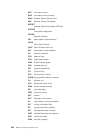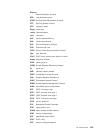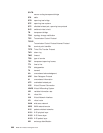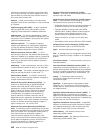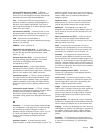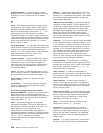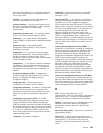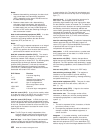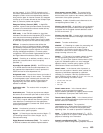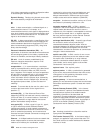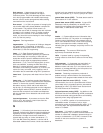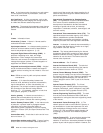broadcast address. In communications, a station
address (eight 1’s) reserved as an address common to
all stations on a link. Synonymous with
all-stations
address
.
C
cache. (1) A special-purpose buffer storage, smaller
and faster than main storage, used to hold a copy of
instructions and data obtained from main storage and
likely to be needed next by the processor. (T) (2) A
buffer storage that contains frequently accessed
instructions and data; it is used to reduce access time.
(3) An optional part of the directory database in network
nodes where frequently used directory information may
be stored to speed directory searches. (4) To place,
hide, or store in a cache.
call request packet. (1) A call supervision packet that
a data terminal equipment (DTE) transmits to ask that a
connection for a call be established throughout the
network. (2) In X.25 communications, a call supervision
packet transmitted by a DTE to ask for a call
establishment through the network.
canonical address. In LANs, the IEEE 802.1 format
for the transmission of medium access control (MAC)
addresses for token-ring and Ethernet adapters. In
canonical format, the least significant (rightmost) bit of
each address byte is transmitted first. Contrast with
noncanonical address
.
carrier. An electric or electromagnetic wave or pulse
train that may be varied by a signal bearing information
to be transmitted over a communication system. (T)
carrier detect. Synonym for
received line signal
detector (RLSD)
.
carrier sense. In a local area network, an ongoing
activity of a data station to detect whether another
station is transmitting. (T)
carrier sense multiple access with collision
detection (CSMA/CD). A protocol that requires carrier
sense and in which a transmitting data station that
detects another signal while transmitting, stops sending,
sends a jam signal, and then waits for a variable time
before trying again. (T) (A)
CCITT. International Telegraph and Telephone
Consultative Committee. This was an organization of
the International Telecommunication Union (ITU). On 1
March 1993 the ITU was reorganized, and
responsibilities for standardization were placed in a
subordinate organization named the Telecommunication
Standardization Sector of the Telecommunication Union
(ITU-TS). “CCITT” continues to be used for
recommendations that were approved before the
reorganization.
channel. (1) A path along which signals can be sent,
for example, data channel, output channel. (A) (2) A
functional unit, controlled by the processor, that handles
the transfer of data between processor storage and
local peripheral equipment.
channel service unit (CSU). A unit that provides the
interface to a digital network. The CSU provides line
conditioning (or equalization) functions, which keep the
signal’s performance consistent across the channel
bandwidth; signal reshaping, which constitutes the
binary pulse stream; and loopback testing, which
includes the transmission of test signals between the
CSU and the network carrier’s office channel unit. See
also
data service unit (DSU)
.
checksum. (1) The sum of a group of data associated
with the group and used for checking purposes. (T) (2)
In error detection, a function of all bits in a block. If the
written and calculated sums do not agree, an error is
indicated. (3) On a diskette, data written in a sector for
error detection purposes; a calculated checksum that
does not match the checksum of data written in the
sector indicates a bad sector. The data are either
numeric or other character strings regarded as numeric
for the purpose of calculating the checksum.
circuit switching. (1) A process that, on demand,
connects two or more data terminal equipment (DTEs)
and permits the exclusive use of a data circuit between
them until the connection is released. (I) (A) (2)
Synonymous with
line switching
.
class A network. In Internet communications, a
network in which the high-order (most significant) bit of
the IP address is set to 0 and the host ID occupies the
three low-order octets.
class B network. In Internet communications, a
network in which the two high-order (most significant
and next-to-most significant) bits of the IP address are
set to 1 and 0, respectively, and the host ID occupies
the two low-order octets.
class of service (COS). A set of characteristics (such
as route security, transmission priority, and bandwidth)
used to construct a route between session partners.
The class of service is derived from a mode name
specified by the initiator of a session.
client. (1) A functional unit that receives shared
services from a server. (T) (2) A user.
client/server. In communications, the model of
interaction in distributed data processing in which a
program at one site sends a request to a program at
another site and awaits a response. The requesting
program is called a client; the answering program is
called a server.
clocking. (1) In binary synchronous communication,
the use of clock pulses to control synchronization of
450 MRS V3.2 Protocol Config Ref Vol 2



